Question:How can I receive articles like this every day??
Just click on the blue text above the arrow!

Introduction: In Traditional Chinese Medicine (TCM), diagnosis involves four methods: observation, listening, inquiry, and palpation. These methods combined allow for a more accurate determination of the disease mechanism, especially pulse diagnosis, which is the most immediate and precise.
However, among these four methods, the general public can effectively use self-examination through tongue observation and changes in tongue coating to understand their overall health and disease status. Below are descriptions of several common tongue coatings, which we hope will be helpful to you.
“The SOS Signals on the Tongue (Part 1)” by Luo Dalun
“The SOS Signals on the Tongue (Part 2)” by Luo Dalun
Normal Tongue Appearance
The tongue is soft, flexible, light red in color, and covered with a thin, evenly distributed, moderately moist white coating, often described as “light red tongue with thin white coating.”
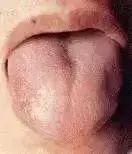
Observing the tongue mainly involves examining the changes in tongue quality and coating. The tongue quality, also known as the tongue body, is the muscular and vascular tissue of the tongue. The tongue coating is a layer of substance attached to the tongue body, generated by stomach qi. The term “stomach qi” refers to the healthy transformation and transportation by the spleen, which governs the reception of food (indicating normal digestive function). When the spleen and stomach function normally, a thin and moist tongue coating can be observed.
During the pathological changes of the body, the fluctuations of yin and yang, the harmony of qi and blood, and the existence of body fluids can all be directly reflected in the changes of the tongue coating. By observing the changes in the tongue coating, one can infer the condition of the internal organs (organ dysfunction) and the severity of the disease.
Cracked Tongue
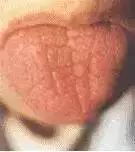
Illustration: The tongue surface shows varying degrees of cracks, which are referred to as a cracked tongue.
Main Diseases and Related Research: A cracked tongue is often a sign of yin deficiency with excessive heat.
Main Diseases of Cracked Tongue:
(1) Excessive heat injuring yin, often presenting as a red tongue with cracks;
(2) Blood deficiency leading to lack of moisture, often presenting as a pale tongue with cracks;
(3) Spleen deficiency with dampness, often presenting as a pale, swollen tongue with teeth marks and cracks. Treatment should focus on nourishing yin essence, benefiting qi, and generating fluids; tonifying the spleen and draining dampness; nourishing yin and clearing heat; and moistening dryness. Additionally, a cracked tongue refers to cracks in the tongue body as well as cracks in the tongue coating; during diagnosis, one should differentiate based on the dryness or moisture of the coating. If the cracks are due to dryness, it indicates an external pathogenic disease with heat injuring fluids, leading to severe dryness.
If the coating has moisture but is cracked, it is often due to qi deficiency. Modern research suggests that shallow cracks on the tongue are primarily due to atrophy of the tongue mucosa, causing the longitudinal or transverse grooves to become visible, while deep cracks indicate more severe atrophic changes in the tongue, leading to loss of normal structure in the epithelial layer, with some papillae becoming flattened and fused, while others atrophy and break, resulting in visible cracks, with thickened scar tissue underneath.
According to the “Tongue Diagnosis Guide: Identifying Tongue Quality”, a normal tongue has no cracks, while the presence of cracks indicates blood deficiency, with the depth and number of cracks reflecting the severity of blood deficiency.
—— Horizontal cracks on the tongue indicate a deficiency of yin, such as ice crystal-like cracks, often seen in elderly individuals with yin deficiency;
—— A red tongue with no coating or with short horizontal cracks indicates yin deficiency with fluid depletion;
—— A tongue with cracks resembling the shape of a person or a river indicates dryness and heat in the stomach, leading to fluid depletion and internal heat.
—— A red tongue with cracks resembling a person indicates the initial invasion of evil into the heart or the misuse of cooling herbs in yin conditions;
—— A red tongue with cracks and significant thirst indicates upper-jiao consumption;
—— A tongue with thick yellow coating and cracks indicates internal heat in the organs;
—— A tongue with no coating and cracks indicates yin deficiency with fiery inflammation;
—— A dry, cracked red tongue indicates evil heat entering the liver or significant damage to yin fluids;
—— A cracked tongue without a smooth surface indicates insufficient stomach yin, with phlegm-heat accumulation;
—— If the tongue is red with a broken tip and blood spots, it indicates significant depletion of yin fluids and intense heart fire;
—— A yellow tongue with tiger stripes indicates both qi and blood deficiency;
—— A red tongue with black stripes indicates a cold condition of the yang qi;
—— A tongue with horizontal cracks at the back indicates kidney qi affecting the heart;
—— A tongue with streaks indicates a deficiency of stomach qi;
—— A pale tongue with numerous cracks indicates spleen deficiency with dampness;
A red tongue with several black stripes and a slippery coating indicates a cold condition of water overpowering fire;
—— A tongue with blue streaks indicates weak stomach qi in febrile diseases, or cold accumulation in various diseases;
—— A cracked tongue with bleeding indicates scorching of blood, with bleeding at the tip indicating intense heart fire.
—— Due to the complexity of cracked tongue syndromes, they are relatively rare in clinical diseases. Specific references can be made to various syndromes. Patients with this type of tongue appearance generally have complex conditions, and treatment should be based on syndrome differentiation.
Fat Tongue
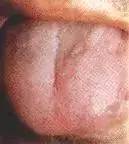
Illustration: A fat tongue is characterized by a swollen, soft, pale tongue, often with teeth marks on the edges.
Main Diseases and Related Research: The fat tongue is also discussed in ancient texts in relation to swollen tongue. In fact, a fat tongue is caused by deficiency of spleen yang qi, or combined with cold dampness, leading to a swollen, soft, pale tongue, often with teeth marks, indicating a deficiency condition, which should be distinguished from a swollen tongue.
Main Diseases of Fat Tongue:
(1) Spleen deficiency, presenting as a swollen, soft, pale tongue with teeth marks, thin white coating, pale face, cold body, fatigue, reduced appetite, abdominal fullness, loose stools, and a weak pulse. This is often due to water and phlegm dampness obstructing the spleen, leading to tongue swelling. If the tongue is pale and moist, it indicates deficiency of spleen and kidney yang, with qi unable to transform fluids, leading to water and dampness rising. Treatment should focus on tonifying the spleen and benefiting qi, using formulas like “Li Zhong Tang” or “Bu Zhong Yi Qi Tang”.
Clinically, this tongue appearance is often seen in patients with obesity, hypothyroidism, anemia, etc. Common TCM formulas include: Ren Shen Jian Pi Wan, Huo Xiang Zheng Qi Wan, Shen Ling Bai Zhu Wan, Fu Zi Li Zhong Wan, and Jia Wei Bao He Wan.
(2) Kidney deficiency with water overflow, presenting as a large, swollen, pale tongue with teeth marks, significant swelling below the waist, reduced urination, cold body, fatigue, dark or pale complexion, and a deep, slow pulse. Treatment should focus on warming yang and promoting urination, using formulas like Jin Gui Shen Qi Wan or Zhen Wu Tang. Additionally, if the tongue is pale and swollen with a yellow, greasy coating, it often indicates damp-heat in the spleen and stomach, with phlegm turbidity rising. Treatment should focus on transforming dampness and resolving phlegm, using herbs like Yin Chen, Mu Tong, Hua Shi, Shi Gao, and Zhi Zi to clear heat and drain dampness. Clinically, this tongue appearance is often seen in patients with chronic glomerulonephritis, pyelonephritis, etc. Common TCM formulas include: Jin Gui Shen Qi Wan, Ji Sheng Shen Qi Wan, Bu Yao Jian Shen Gao, Shen Yan Wen Yang Pian, and Shen Yan Xiao Zhong Pian.
Teeth-marked Tongue
Illustration: A teeth-marked tongue shows impressions of teeth along the edges of the tongue.
Main Diseases and Related Research: A teeth-marked tongue is often caused by the tongue being swollen and pressed by the teeth, thus it is often seen together with a fat tongue, indicating spleen deficiency and a deficiency syndrome. If the tongue is pale and moist, it indicates spleen deficiency with cold dampness.
The cause of a teeth-marked tongue is often due to spleen deficiency failing to transform water and dampness, leading to dampness obstructing the tongue and causing swelling, which is then pressed by the teeth, hence the teeth marks are often seen together with a fat tongue. On one hand, this is due to tongue edema, indicating spleen yang deficiency with excessive dampness; on the other hand, it is due to relaxation of the tongue muscles, insufficient opening of the mouth, indicating spleen qi deficiency.
Main Diseases of Teeth-marked Tongue:
—— Pale and moist with teeth marks indicates excessive cold dampness;
—— Pale red with teeth marks indicates spleen deficiency or qi deficiency;
—— Red and swollen with teeth marks indicates damp-heat and phlegm obstruction;
In summary, it can be divided into qi deficiency and yang deficiency types:
(1) Qi deficiency type: Spleen qi deficiency, main symptoms: pale tongue, thin white coating, swollen tongue, teeth marks on the edges, pale or sallow complexion, shortness of breath, fatigue, self-sweating, reduced appetite, abdominal distension, loose stools, and a weak pulse. Treatment should focus on tonifying qi.
(2) Yang deficiency type: Main symptoms: pale tongue, moist with much fluid, or slippery tongue surface, swollen tongue, teeth marks on the edges. Pale or dark complexion, fatigue, preference for warmth, pale thirst, reduced appetite, cold abdominal pain, relief with warmth, cold limbs, clear urine, or edema, and a deep, weak pulse. Treatment should focus on warming and tonifying yang. Common TCM formulas include: Ren Shen Jian Pi Wan, Huo Xiang Zheng Qi Wan, Shen Ling Bai Zhu Wan, Fu Zi Li Zhong Wan, and Jia Wei Bao He Wan.
Thin White Coating
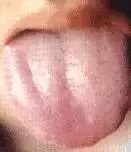
Illustration: A thin white coating covers the tongue surface, evenly distributed, with moderate dryness and moisture.
Main Diseases and Related Research: A thin white coating, with a light red and moist tongue, is the most common tongue coating under normal conditions, indicating “stomach qi”. The formation of a thin white coating is mainly due to the combined effects of chewing, swallowing, saliva, and diet, which continuously remove and shed substances between the filiform papillae of the tongue mucosa and the keratinized epithelium, resulting in only a thin white layer of coating.
A thin white coating forms when external pathogens such as wind-cold, wind-dampness, and cold-dampness (the six excesses include wind, cold, heat, dampness, dryness, and fire) are present at the surface (superficial or early stage), and have not yet penetrated deeper (worsening or developing), and the pathogenic factors (disease condition) are relatively mild, while the internal organ qi (organ function) is not harmed. Therefore, it is often said that “thin white coating indicates a superficial condition”.
According to the “Tongue Diagnosis Guide”, “If the tongue coating is white, moist, and thin, the evil is in the wei level (in TCM, the wei, qi, ying, and blood levels are divided into four layers from superficial to deep, with wei being the lightest level), it can be treated with sweating methods, such as using Ma Huang and Qiang Huo.” Commonly seen thin white coatings are often associated with external wind-cold conditions. If accompanied by symptoms such as chills, fever, body aches, and stiff neck, with no sweat or little sweat, and a floating tight pulse, one can use Ma Huang Tang with modifications; if the tongue is red with a thin white and moist coating, it indicates external wind-heat or external wind-cold transforming into heat, and one can use Yin Qiao San with modifications. Common TCM formulas include: Gan Mao Qing Re Chong Ji, Tong Xuan Li Fei Kou Fu Ye, etc.
Thin White Dry Coating
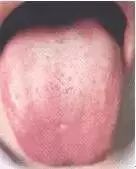
Illustration: A thin white dry coating appears on the tongue, with less fluid and a tendency to dryness.
Main Diseases and Related Research: A thin white dry coating is due to damage to lung fluids and qi. When qi is deficient, it cannot transform fluids; when fluids are scarce, it cannot moisten the tongue, leading to dryness due to lack of nourishment.
Main Diseases of Thin White Dry Coating: Often seen in wind-heat entering the lungs, where the evil qi injures the lungs, or due to yang deficiency failing to transform fluids. In the former case, one should clear and moisten, using Yin Qiao San with methods to nourish yin and clear heat; in the latter case, one should benefit qi and generate fluids, using Xuan Fei Yi Qi Tang or methods to raise yang and benefit qi.
The above thin white dry coating, if accompanied by symptoms such as cold, cough, and white phlegm, can refer to medication. Common TCM formulas include: Yin Qiao Jie Du Wan, Yin Qiao Jie Du Chong Ji, Yin Huang Kou Fu Ye, Qiong Ju Shang Qing Wan, Qing Re Jie Du Kou Fu Ye, Yang Yin Qing Fei Wan, Yang Yin Qing Fei Kou Fu Ye, Shuang Huang Lian Kou Fu Ye, Tong Xuan Li Fei Wan, Tong Xuan Li Fei Kou Fu Ye, Ji Zhi Tang, Zhi Ke Ju Hong Kou Fu Ye.
Thick White Greasy Coating
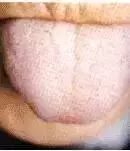
Illustration: A thick white greasy coating appears on the tongue, with the coating being white and thick, either tightly packed or loose, covering the entire tongue or being thinner at the edges.
Main Diseases and Related Research: A thick white greasy coating is often due to insufficient yang qi in the middle jiao, leading to stagnation of food, or due to dampness and phlegm accumulation. According to the “Tongue Diagnosis Guide”: “A white greasy coating indicates chest oppression and pain, irritability, and dry vomiting; one often desires to drink water, but water leads to vomiting. This is due to heat caused by stagnation of fluids, and one should use light and bland methods to transform fluids.”
Main Diseases of Thick White Greasy Coating: It indicates dampness, phlegm, and cold. A white greasy coating due to external cold dampness indicates the invasion of cold dampness. Cold causes the tongue to appear white, while dampness leads to a greasy coating; since cold dampness is at the surface, the tongue may appear thin and greasy. Treatment should focus on warming and dispersing cold dampness, using Qiang Huo Sheng Shi Tang. A white greasy coating due to internal dampness indicates the invasion of damp-heat pathogens, which may also be caused by internal dampness combined with external pathogens. Damp-heat enters the interior, accumulating between the membranes. When yang qi is obstructed, dampness rises, leading to a thick white greasy coating, or a coating that appears like accumulated powder.
— It is worth noting that heat caused by fluid stagnation leads to a thick white greasy coating without yellow coating; however, there is still internal heat, which can lead to irritability and dry vomiting, indicating that this condition is different from damp-heat causing yellow coating. Clinically, this tongue appearance is often seen in patients with bronchial asthma, pulmonary emphysema, pulmonary heart disease, rheumatic heart disease, and heart failure. Patients with this type of tongue appearance generally have complex conditions, and treatment should be based on syndrome differentiation. Some TCM formulas can also be used based on the syndrome.
White Coating Dry Cracked Tongue
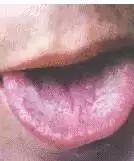
Illustration: A white cracked coating appears on the tongue, which can be thin or thick, with rough and loose granules, dry and hard, resembling sand or stones.
Main Diseases and Related Research: White cracked coating can appear simultaneously on the tongue, hence it is collectively referred to as white cracked coating. This is primarily caused by sudden internal heat and rapid damage to fluids. It is often seen in acute warm diseases, where sudden heat damages fluids, and true yin is about to deplete, while the coating has not yet turned yellow. If the coating is white and cracked but not too dry, it is often seen in summer heat, where summer heat injures qi, combined with dampness.
According to the “Tongue Diagnosis Guide”: “A white cracked coating indicates that due to improper use of warming tonics, true yin is burned, and if there is no yellow or black color, it indicates that true yin is about to deplete, with the tongue lacking moisture, and the coating has dried out, hence it cannot show other colors.”
Main Diseases of White Cracked Coating: It indicates sudden heat injuring fluids; treatment should focus on generating fluids and clearing heat; it indicates summer heat injuring qi, combined with dampness, treatment should focus on clearing summer heat and benefiting qi. Clinically, this tongue appearance is often seen in patients with external heat diseases and acute infectious diseases. Common TCM formulas include: Zi Xue San, Ling Qiao Jie Du Wan, Ban Lan Gen Chong Ji, etc.
Yellow Greasy Coating
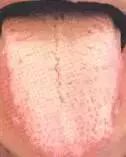
Illustration: A yellow greasy coating appears on the tongue, with tightly packed granules and a yellow powdery layer on the tongue surface.
Main Diseases and Related Research: A yellow greasy coating is formed by the combination of evil heat and phlegm dampness. A yellow coating indicates heat, while a greasy coating indicates dampness, phlegm, or food stagnation.
Main Diseases of Yellow Greasy Coating: It indicates damp-heat accumulation, phlegm transforming into heat, or food stagnation transforming into heat; it also indicates external summer heat or damp-warm conditions. Treatment should focus on clearing heat, transforming dampness, and resolving phlegm. Additionally, when identifying yellow greasy coating, one should also consider the tongue quality.
—— If the tongue is pale red with a yellow coating covering the tongue surface, with a moist and not dry coating; if the edges are slightly white, it indicates that external evil has transformed into heat, entering the yangming stomach and causing this condition. The main disease is heat entering the yangming level, qi level damp-heat syndrome, liver and gallbladder diseases, and urinary tract infections, as well as various febrile diseases. Treatment should focus on clearing heat and detoxifying, and unblocking the exterior and interior.
—— If the tongue is red with a yellow greasy coating, thick and with thin edges, tightly packed and fine, especially at the root, it indicates that heat phlegm is intermingled, or dampness has entered the interior and transformed into heat, or warm heat has accumulated in the stomach and intestines, but has not yet reached the yangming level.
—— If the tongue is deep red and shiny, it indicates a severe condition of heat phlegm intermingling, damp-heat in the middle jiao, and food stagnation in the stomach and intestines. Treatment should focus on clearing heat, transforming dampness, and eliminating stagnation. If the tongue is purple with a gray-yellow thick coating, moist but not dry, it indicates a mixed condition of cold and heat, where heat transforms from cold, or cold transforms from heat, indicating a critical condition, often due to unresolved febrile diseases, severe heart yang deficiency, and phlegm accumulation. Treatment should focus on warming the heart and kidney, reviving yang, clearing heat, and invigorating blood.
—— If the tongue is purple and dark with a yellow greasy coating, the tongue body is swollen, and the surface is covered with yellow coating, mixed with white coating, especially at the root, it indicates that the formation may be due to food stagnation, phlegm dampness, or cold evil stagnation, or due to damp food obstructing the middle jiao, leading to qi and blood stagnation. Treatment should focus on warming yang, tonifying the spleen, and invigorating blood to eliminate accumulation.
Clinically, this tongue appearance is often seen in patients with acute and chronic gastroenteritis, cholecystitis, and uremia. Patients with this type of tongue appearance generally have complex conditions, and treatment should be based on syndrome differentiation.
Yellow Dry Coating

Illustration: A yellow dry coating appears on the tongue, indicating a lack of fluids (jin). This is a manifestation of evil heat injuring fluids.
Main Diseases and Related Research: The causes of yellow dry coating are varied:
(1) A thin yellow coating indicates that the external evil has transformed into heat and entered the interior, injuring fluids;
(2) A yellow coating that is dry indicates excessive heat in the qi level, with fluids already injured;
(3) A dry yellow coating covering the entire tongue indicates a solid heat condition in the interior;
(4) If the coating is old yellow and dry with cracks, or has cracks, it indicates that the exterior evil has been resolved, and the evil qi has entered the interior, accumulating in the organs.
(5) If the coating changes from thick to thin, and from dark to light, dry and with little fluid, it indicates that although the evil heat has retreated, the fluids have not yet been generated.
Main Diseases of Yellow Dry Coating: It indicates evil heat entering the interior; treatment should focus on clearing heat and purging the interior. If there is excessive heat in the qi level injuring fluids, one should use cold and bitter herbs to clear qi and drain heat. If there is solid heat in the interior, one should use bitter cold herbs to purge and drain heat. If the heat has retreated but fluids are still injured, treatment should focus on nourishing fluids. Since yellow dry coating often accompanies complex main diseases, the choice of medication should also be based on the condition. Common TCM formulas for clearing heat and detoxifying include: Qing Re Jie Du Wan, Xin Qing Ning Pian, Zi Xue San, An Gong Niu Huang Wan, etc.
Yellow Coating
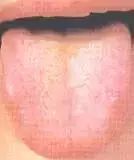
Illustration: Yellow coating is a common pathological tongue coating, which can also be seen in some healthy individuals.
Main Diseases and Related Research: The yellow coating seen in healthy individuals is mainly thin yellow coating and thin yellow greasy coating. Thick yellow greasy coating increases with age. Yellow coating can be light yellow, tender yellow, deep yellow, or burnt yellow, often distributed at the root and center of the tongue, and can also cover the entire tongue. As mentioned earlier, yellow coating can also be seen with other colors such as white coating, and among various yellow coatings, there are differences in thickness, moisture, and greasiness.
Main Diseases of Yellow Coating: It indicates spleen and stomach diseases, interior conditions, and heat conditions. The “Comprehensive Guide to Tongue Diagnosis” states that yellow coating can be present in both excess heat conditions and in cases of deficiency cold. Evil heat scorching leads to yellow coating; light yellow indicates mild heat; deep yellow indicates severe heat; burnt yellow indicates heat accumulation. The tongue coating changing from white to yellow indicates that the exterior evil has entered the interior and transformed into heat; in febrile diseases, this belongs to the yangming level; in warm diseases, it belongs to the qi level. While exterior conditions and deficiency cold conditions can also show yellow coating: if there is thin white with light yellow coating, it indicates wind-heat exterior condition or wind-cold transforming into heat; if there is light yellow thick coating, it indicates damp-heat in the chest cavity, with qi stagnation. If the tongue is swollen and tender, with yellow slippery coating, it indicates yang deficiency with water mixed downwards. Therefore, yellow coating indicates interior conditions, but it is not absolute.
Modern research on the formation mechanism of yellow coating:
(1) The formation of yellow coating is related to elevated body temperature;
(2) Yellow coating is associated with inflammatory infections;
(3) Yellow coating is related to digestive dysfunction;
(4) Yellow coating is associated with microbial activity. In summary, researchers believe that yellow coating is most closely related to infections, inflammation, and fever, leading to digestive dysfunction, resulting in the proliferation of filiform papillae on the tongue, reduced secretion from the salivary glands, and local pigmentation, along with localized inflammatory exudation and microbial activity, all contributing to the formation of yellow coating.
Thin Yellow Coating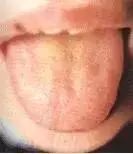
Illustration: The tongue has a yellow coating, with thin yellow coating being a light yellow mixed with thin white coating.
Main Diseases and Related Research: Thin yellow coating is a common pathological tongue coating, which can also be seen in some healthy individuals. Common yellow coatings are mainly thin yellow coating and thin yellow greasy coating. Thick yellow greasy coating increases with age. Thin yellow coating often develops from white coating, indicating that the condition has transformed from cold (one of the six excesses) to heat, moving from the exterior to the interior (worsening or prolonged condition).
The “Treatise on Febrile Diseases” states: “If the yellow coating is floating and thin, it indicates that the heat is in the lungs and has not yet entered the stomach.” Here, the lungs refer to the wei level (the lightest level in TCM), while the stomach refers to the interior condition.
—— If the thin yellow coating is moist, it indicates that the exterior evil has just entered the interior, with mild heat and no injury to fluids; treatment should focus on clearing heat and releasing the exterior;
—— If the thin yellow coating is dry, it indicates that the patient does not feel cold but rather feels hot, indicating that the exterior evil has just entered the yangming (stomach) level, or that warm heat is about to enter the qi level, indicating that there is heat in the stomach but not yet severe; treatment should use sweet cold light herbs to nourish fluids;
—— If the tongue is thin white with a light yellow coating, it indicates wind-heat at the surface or wind-cold transforming into heat, and one should use spicy cool herbs to release the exterior.
The above thin yellow coating, if accompanied by symptoms such as fever, headache, dry throat, fatigue, and coughing with yellow phlegm, can refer to medication. Common TCM formulas include: Yin Qiao Jie Du Wan, Yin Qiao Jie Du Chong Ji, Yin Huang Kou Fu Ye, Qiong Ju Shang Qing Wan, Qing Re Jie Du Kou Fu Ye, Yang Yin Qing Fei Wan, Yang Yin Qing Fei Kou Fu Ye, Shuang Huang Lian Kou Fu Ye, Tong Xuan Li Fei Wan, Tong Xuan Li Fei Kou Fu Ye, Ji Zhi Tang, Zhi Ke Ju Hong Kou Fu Ye.
Gray Coating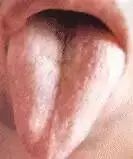
Illustration: A gray coating appears on the tongue, which is gray with black tones, referred to as “gray-black tongue coating”.
Main Diseases and Related Research: Gray coating, strictly speaking, differs in color and main diseases from black coating. However, as the coating darkens, it becomes gray; deep gray indicates black. Gray coating generally indicates a milder condition than black coating, but both are closely related as the disease progresses.
Gray coating often develops from white coating becoming dull or may appear simultaneously with yellow coating. According to the “Tongue Diagnosis Guide: Identifying Tongue Color”: “Gray coating is a lighter form of black coating. If blue and yellow mix into black, it becomes gray; it should be treated similarly to black coating.” Generally, it indicates an interior condition, but there are distinctions between cold and heat.
According to the “Treatise on Febrile Diseases”: “A gray-black coating that is slippery indicates that cold water is harming the earth, indicating a cold condition in the taiyin. If gray coating appears with other symptoms, it indicates that phlegm dampness is harming the spleen, and treatment should focus on warming the middle and harmonizing the spleen to eliminate dampness.” It can be seen that gray coating is often moist, indicating phlegm dampness accumulation; if the coating is gray and dry, it often indicates heat injuring fluids, seen in external heat diseases or yin deficiency with excessive fire, indicating internal injuries. Evil heat entering the interior, epidemic diseases, and blood stasis can also present with gray coating.
Main Diseases of Gray Coating: Gray coating that is dry indicates yangming organ excess, with yin fluids already injured; if there is excess in the organs, treatment should focus on purging with bitter cold herbs; if there is no excess in the organs, with a fine rapid pulse, treatment should focus on bitter cold herbs to rescue fluids. If gray coating is slippery, it indicates phlegm dampness accumulation, with warm diseases combined with phlegm dampness; if accompanied by other severe symptoms, one should differentiate carefully. Treatment should focus on warming the middle, drying dampness, and using aromatic herbs to clear and transform. Gray coating that is slippery and moist, with vomiting and a fine pulse, indicates yang deficiency with cold symptoms; treatment should focus on warming yang and dispelling cold, using formulas like Si Ni San or Li Zhong Tang.
焦黄苔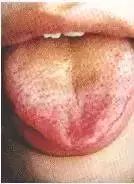
Illustration:焦黄苔: The tongue shows a coating that is old yellow and burnt, or thick and deep yellow, especially at the center or root.
Main Diseases and Related Research:焦黄苔 indicates a condition of solid heat accumulation in the stomach. The “Tongue Diagnosis Guide” states: “If the coating is yellow and dry, it indicates damage to stomach fluids; if it is old yellow and cracked, it indicates severe heat; if it is very old yellow and black, it indicates extreme heat resembling water, requiring urgent treatment; if it is yellow and dry with sharp edges, it indicates corruption in the stomach and intestines.” If the tongue quality is examined, it can be divided into pale white tongue with焦黄苔, indicating a larger tongue body, pale tongue quality, and a tongue tip with yellow coating mixed with white, with the root being dry and lacking fluids, presenting a焦黄 appearance. Yellow coating indicates excessive heat in the stomach, often due to the invasion of pathogens transforming into heat.
Main Diseases: It indicates excess in the yangming organs, excess heat in the three jiao organs, or late-stage warm diseases, with damage to stomach and kidney yin, as well as various febrile diseases and infectious diseases. Treatment should focus on purging with bitter cold herbs, clearing heat, and nourishing fluids. If the tongue is red with焦黄苔, with a red tongue and purple edges, and焦黄苔 at the root, it indicates the invasion of external evil, transforming into fire and injuring the营血, leading to fluid depletion, and damage to the stomach and intestines. The tongue quality changes from red to焦黄, indicating that fluids are depleted. The main diseases include warm heat invading the营血, or combined with yangming excess heat, various infectious diseases, and prolonged fever. Treatment should focus on clearing heat, purging the interior, cooling the blood, and detoxifying. Due to the complexity of焦黄苔, it is often seen in various clinical diseases, and specific references can be made to various syndromes. Patients with this type of tongue appearance generally have complex conditions, and treatment should be based on syndrome differentiation.
淡白少津舌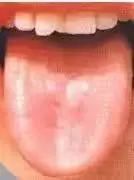
Illustration: The tongue shows a lack of fluids, even to the point of being dry.
Main Diseases and Related Research: A淡白少津舌 is often due to deficiency of yang qi, which cannot generate fluids, or due to yang deficiency leading to water stagnation, resulting in insufficient fluids on the tongue. The tongue appears pale white and lacks fluids, as fluids are transformed from food essence through the warming action of yang qi, and then distributed throughout the body by yang qi. If the middle and upper jiao (spleen and lungs) yang qi is weak, the spleen cannot generate fluids, and the lung qi cannot distribute fluids. For example, in patients with abdominal water retention, the tongue may appear dry, indicating a deficiency of fluids.
Main Diseases of淡白少津舌: Yang qi deficiency, insufficient fluids. Treatment should focus on tonifying yang, benefiting qi, and generating fluids. Clinically, this tongue appearance is often seen in patients with chronic atrophic gastritis, mild anemia, etc. If the above tongue appearance is accompanied by symptoms such as spleen and stomach disharmony—abdominal distension, lack of appetite, bland taste, vomiting, heaviness in the limbs, thick white greasy coating, and a slow pulse, one can try using herbs to tonify the spleen and dry dampness; if there is spleen and stomach cold—subtle abdominal pain, vomiting clear fluids, preference for warmth, reduced appetite, fatigue, and a pale tongue, one can try using herbs to tonify the spleen, open the appetite, and move qi; common TCM formulas include: Ping Wei Wan, Xiang Sha Zhi Shi Wan, Xiang Sha Yang Wei Wan, Li Zhong Wan, Huang Qi Jian Zhong Wan, and Xiang Sha Liu Jun Zi Wan.
淡白夹瘀舌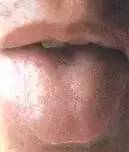
Illustration: The tongue has a thin white coating, with a pale white tongue and spots of stasis.
Main Diseases and Related Research:淡白夹瘀舌: In ancient literature, there is little discussion about淡白夹瘀舌, but clinically, this tongue appearance does exist. Analyzing its formation, it is often related to blood deficiency combined with stasis. Modern microcirculation studies of the tongue have found that the microvessels within the filiform papillae of a pale white tongue are insufficiently filled, with slow blood flow and narrowed vessel diameters, leading to local blood stasis, resulting in a pale white tongue with spots or dots of stasis on the edges.
Main Diseases: Qi deficiency with blood stasis. Blood deficiency with blood stasis. Clinically, this tongue appearance is often seen in patients with aplastic anemia and various types of severe anemia. Treatment should focus on nourishing blood, benefiting qi, and invigorating blood.
Common TCM Formulas:
—— Qi and blood deficiency: Gui Qi Rong Xue Jing, Ba Zhen Wan, etc.
—— Spleen and kidney yang deficiency: Xue Su Sheng Chong Ji, Zai Zheng Sheng Xue Pian, Sheng Xue Wan, etc.
淡白湿润舌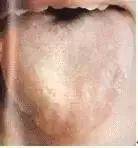
Illustration: The淡白湿润舌 shows a pale white tongue, which is moist or has much fluid.
Main Diseases and Related Research: The former pale white tongue indicates qi and blood deficiency, with a normal or slightly small tongue size. Qi deficiency cannot generate blood, or blood deficiency leads to qi deficiency, resulting in both qi and blood deficiency. This condition cannot nourish the tongue surface, often due to prolonged illness or excessive blood loss. Treatment should focus on tonifying both qi and blood, using formulas like Shi Quan Da Bu Tang, etc. The latter moist tongue indicates spleen deficiency with cold dampness, with a swollen tongue and teeth marks on the edges, often due to spleen yang deficiency, leading to insufficient transformation of fluids, resulting in a pale white tongue. Treatment should focus on warming the spleen, assisting yang, and dispelling dampness.
Clinically, this tongue appearance is often seen in deficiency syndromes, especially in patients with significant blood loss. Common TCM formulas for tonifying qi and blood include: Jin Gui Shen Qi Wan, Cong Rong Bu Shen Wan, Quan Lu Wan, Wu Ji Bai Feng Wan, Ren Shen Yang Rong Wan, and An Kun Zhan Yu Wan.
Bright Red Cracked Tongue
Illustration: The tongue is bright red, with cracks resembling a person or other shapes.
Main Diseases and Related Research: A bright red cracked tongue indicates heart fire scorching and heat toxins invading; if the tongue is deep red with uneven white coating or no coating, with many deep cracks resembling knife cuts, it often indicates excessive fire in the heart, or true yin depletion. If the tongue has fragmented cracks, it indicates blood depletion and fluid dryness. If the cracks resemble the shape of a person or river, it indicates excessive heat injuring fluids, burning stomach fluids, or kidney water attacking the heart.
Main Diseases of Bright Red Cracked Tongue: Yin deficiency with heat, evil entering the营血, insufficient stomach yin, and phlegm-heat accumulation. Treatment should focus on clearing the heart, draining heat, and nourishing yin fluids. Clinically, this tongue appearance is often seen in patients with fever, dehydration leading to electrolyte imbalance, diabetes, chronic enteritis, liver cirrhosis, etc. Due to the complexity of bright red cracked tongue syndromes, specific references can be made to various syndromes. Patients with this type of tongue appearance generally have complex conditions, and treatment should be based on syndrome differentiation.
Old Tongue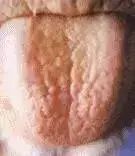
Illustration: The tongue has a rough texture and a hardened appearance, indicating an old tongue.
Main Diseases and Related Research: An old tongue is often due to excessive evil qi and insufficient righteous qi, leading to a hardened and dull appearance. The “Clinical Tongue Examination Method: Differentiating Between Deficiency and Excess” states that if the substance is solid, it indicates excess; if the color is dull, it indicates deficiency. Moreover, if the qi is still young, the substance is still tender; if the qi is strong, the substance is firm. Therefore, regardless of tongue color or coating, an old tongue generally indicates an excess condition. Additionally, excessive heat can lead to qi and blood stagnation, resulting in a hardened tongue appearance, indicating an excess heat condition.
The “Tongue Diagnosis Guide: Identifying Tongue Spirit” also states that a hardened and dull tongue, regardless of coating color, often indicates an excess condition. The “New Method of Tongue Diagnosis: Differentiating Yellow Coating” also states that the tongue quality can be old or tender, and the coating color can also vary. A deep, dark, or dull tongue indicates an old color, or an old coating often indicates an excess condition. Among them, an old yellow coating indicates excessive stomach yang. A yellow color resembling fried orange peel indicates extreme stomach yang, while a yellow-black intermingling indicates severe damage to stomach fluids, leading to dry mouth and tongue. Additionally, if yang qi is obstructed by yin evil, it cannot rise, leading to a lack of fluids. Modern research suggests that the appearance of an old tongue may be related to decreased parasympathetic nervous tension and increased sympathetic nervous tension, leading to reduced serous secretion and increased mucous secretion. An old tongue often presents with various syndromes, and specific references can be made to various syndromes. Patients with this type of tongue appearance generally have complex conditions, and treatment should be based on syndrome differentiation.
Bright Red Dry Tongue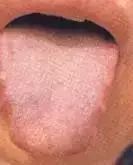
Illustration: The tongue is bright red or deep red, with a dry surface and little fluid.
Main Diseases and Related Research: The “Tongue Diagnosis Guide” states: “A tongue that is bright red and lacks fluids, with the entire tongue appearing bright red, soft and tender but lacking moisture, appears moist but is actually dry and depleted, indicating excessive yin deficiency and fire.” In external heat diseases, when the evil qi enters the interior, the营阴 is damaged, and fluids are depleted, this tongue appearance can be observed. It may also occur in internal injury diseases, where the body is constitutionally deficient, leading to prolonged illness and depletion of both qi and blood, resulting in a lack of fluids. If only the tip of the tongue is bright red and dry, while the rest is pale red, it indicates excessive heart fire.
Main Diseases of Bright Red Dry Tongue: It indicates evil qi entering the interior, damaging营热 and fluids. Treatment should focus on clearing营 and nourishing yin. It indicates excessive yin deficiency and fire, treatment should focus on nourishing yin and lowering fire. It indicates excessive heart fire, treatment should focus on draining heart fire and guiding heat downwards. In summary, any bright red dry tongue due to excessive diarrhea or thirst leading to depletion of both qi and yin, such as dehydration or electrolyte imbalance, can be treated with methods to clear heat, generate fluids, and nourish yin. Due to the complexity of bright red dry tongue syndromes, this tongue appearance is often seen in various clinical diseases, and specific references can be made to various syndromes. Patients with this type of tongue appearance generally have complex conditions, and treatment should be based on syndrome differentiation.

